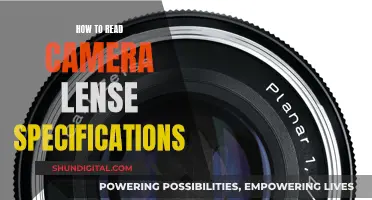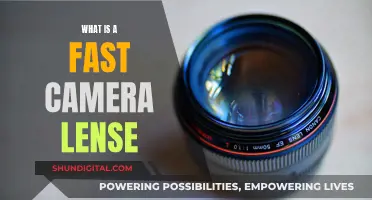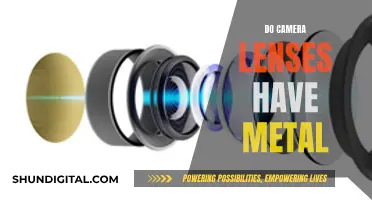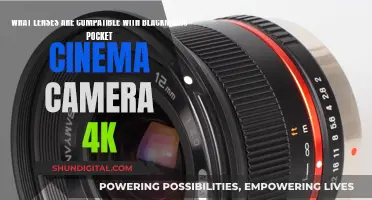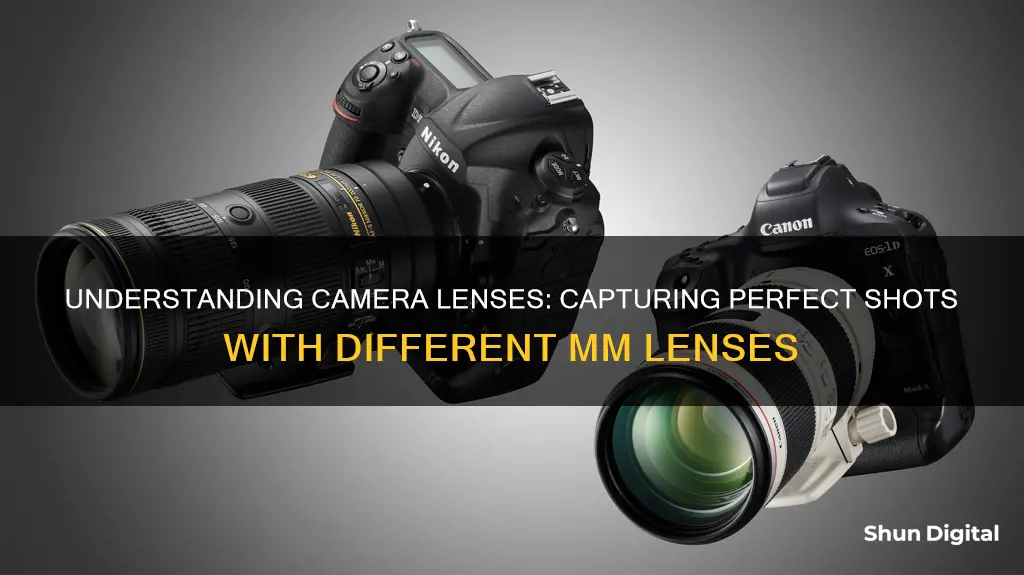
The 'mm' number on a camera lens refers to the focal length, which is measured in millimetres. Focal length is the distance from the optical centre of the lens to the camera's sensor when focused on infinity. In other words, it tells you how much of the scene your camera will capture. A lens with a short focal length is a wide-angle lens, and one with a long focal length is a telephoto lens. Wide-angle lenses have a wider field of view, while telephoto lenses have a narrower field of view.
| Characteristics | Values |
|---|---|
| Unit of measurement | Millimeters (mm) |
| What mm measures | Focal length of a lens |
| Focal length | The distance between the focal point and the sensor |
| Focal length and magnification | A shorter focal length gives a wider angle of view; a higher number gives a narrower angle of view but greater magnification |
| Prime lens | Fixed focal length; lighter and cheaper than zoom lenses; wider maximum aperture; less versatile |
| Zoom lens | Variable focal length; heavier and more expensive than prime lenses; smaller maximum aperture; more versatile |
| Standard lens | Focal length between 35mm and 85mm; field of view similar to the human eye |
| Wide-angle lens | Focal length between 14mm and 35mm; wide field of vision |
| Ultra-wide-angle or fisheye lens | Focal length less than 14mm; enormous field of view; warping effect |
| Telephoto lens | Focal length between 85mm and 300mm; incredible magnification; narrow angle of view |
| Super-telephoto lens | Focal length above 300mm; even greater magnification than telephoto lenses |
| Macro lens | Extreme close-ups; can't be categorised by focal length alone; minimum focus range |
| Tilt-shift lens | Distorts and changes the perspective of a shot; controls depth of field and perspective |
What You'll Learn

Zoom lenses
A zoom lens with focal lengths ranging from 100mm to 400mm may be described as a 4:1 or "4x" zoom. The term "superzoom" or "hyperzoom" is used to describe zoom lenses with very large focal length factors, typically more than 5x and ranging up to 19x in SLR camera lenses and 22x in amateur digital cameras. This ratio can be as high as 300x in professional television camera lenses.
While zoom lenses offer flexibility and convenience, they come at the cost of some drawbacks. Firstly, there is a complexity of design and operation. Secondly, there are compromises on image quality, weight, dimensions, aperture, autofocus performance, and cost. For example, all zoom lenses suffer from at least a slight, if not considerable, loss of image resolution at their maximum aperture, especially at the extremes of their focal length range. This effect is evident in the corners of the image when displayed in a large format or high resolution. The greater the range of focal length a zoom lens offers, the more exaggerated these compromises become.
Some other drawbacks of using a point-and-shoot camera with a large optical zoom lens include noise, pincushioning, slower shutter response time, and increased camera shake. Inexpensive, beginner-level cameras may suffer from lower image quality due to noise when the lens is extended to its maximum zoom capability. Pincushioning is a type of distortion where the left and right edges of the photo appear stretched, and horizontal lines appear slightly curved towards the middle of the frame. Slower shutter response times may cause blurry photos or cause you to miss spontaneous shots. Using a long zoom lens can also cause increased camera shake, which can be mitigated by using a tripod or image stabilisation.
Handcrafted Zeiss Lenses: Precision and Artistry in Optics
You may want to see also

Prime lenses
The main advantage of prime lenses is that they specialise in just one focal length, meaning they are finely tuned to deliver on one specific type of photography. Because of this, prime lenses produce much higher-quality images than zoom lenses.
A 50mm prime lens, also known as the Nifty Fifty, is perfect for portraits as the focal length is seen to be as close to the human eye as possible. A 35mm prime lens, on the other hand, is usually best for landscape photographers.
One drawback of prime lenses is that you can't easily change your field of view while remaining in the same spot. You will need to switch prime lenses more frequently than zooms, which can be time-consuming and expose your camera sensor to dust and debris.
CCD Camera Lenses: Color Corrected or Not?
You may want to see also

Telephoto lenses
A telephoto lens is a type of long-focus lens used in photography and cinematography. The physical length of the lens is shorter than the focal length. This is achieved by incorporating a special lens group, known as a telephoto group, which extends the light path to create a long-focus lens in a shorter overall design. The telephoto group spreads the cone of light so that it appears to have come from a lens with a much greater focal length.
Camera Lens Imperfections: Do Scratches and Marks Affect Quality?
You may want to see also

Wide-angle lenses
Some of the best wide-angle lenses for Nikon cameras include the Nikon 24mm f/1.4G, the Nikon 20mm f/1.8G, the Nikon 10-24mm f/3.5-4.5, the Nikon 14-24mm f/2.8G, and the Nikon 16-35mm f/4 VR.
For Canon cameras, the Canon 16-35mm f/2.8 L II, the Canon 24mm f/1.4 L II, the Canon 28mm f/1.8 USM, the Canon 10-18mm f/4.5-5.6 IS, the Canon 14mm f/2.8L II, and the Canon 17-40mm f/4L are all popular options.
Third-party manufacturers such as Sigma and Tokina also offer wide-angle lenses that are compatible with both Canon and Nikon camera systems.
Capturing Distance: 300mm Lens Vision Explored
You may want to see also

Macro lenses
A "true" macro lens can project subjects onto the camera's sensor at life-size, resulting in a 1.0x Maximum Magnification (MM) at the lens' Minimum Focus Distance (MFD). This means that a small subject will appear identically sized on the camera's sensor. A select few macro lenses exceed life-sized reproduction, while others fall between 0.50x and 1.0x magnification and can also be considered macro lenses as they permit significantly closer focus than typical lenses.
On the other hand, shorter focal length macro lenses are generally smaller, lighter, and less expensive than their longer counterparts. They can achieve the same level of magnification as longer lenses, making them a good option for casual macro photographers.
Some common uses for macro lenses include photographing insects, flowers, jewellery, coins, and other small everyday objects. Macro lenses can also be used to focus on the small details of a larger subject, creating intriguing macro imagery.
The Impact of Constant Lens Usage on Camera Performance
You may want to see also
Frequently asked questions
A wide-angle lens has a focal length of fewer than 50mm, whereas a telephoto lens has a focal length of more than 50mm. Wide-angle lenses are good for landscape photography, while telephoto lenses are better for focusing on specific details or distant subjects.
A zoom lens has a focal length range, meaning it can be used at any point across that range. For example, an 18-200mm lens can be used at its widest angle (18mm), most zoomed (200mm), or anywhere in between.
A prime lens has a single focal length, meaning that to take in more or less of a scene, you will need to get closer to or further away from your subject. Prime lenses are considered to produce higher-quality images than zoom lenses.
A standard zoom lens has a focal length of around 35-70mm, while a superzoom lens covers a wider focal length range, from wide-angle to telephoto. Superzooms are good travel lenses as they are versatile and mean you don't have to carry lots of different gear.



